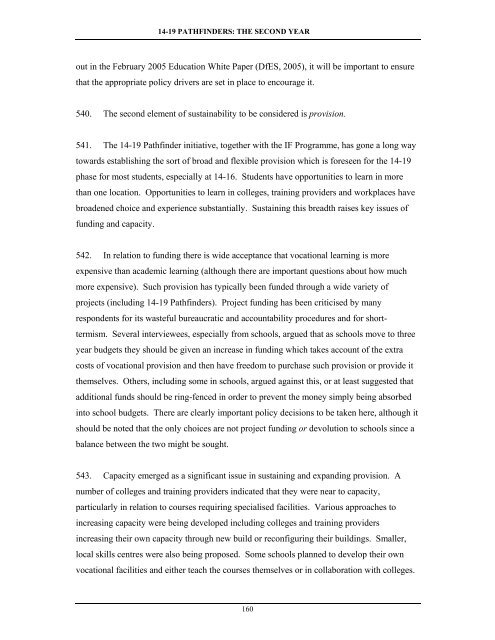Collaborative Approaches to 14-19 Provision - Communities and ...
Collaborative Approaches to 14-19 Provision - Communities and ...
Collaborative Approaches to 14-19 Provision - Communities and ...
- No tags were found...
You also want an ePaper? Increase the reach of your titles
YUMPU automatically turns print PDFs into web optimized ePapers that Google loves.
<strong>14</strong>-<strong>19</strong> PATHFINDERS: THE SECOND YEARout in the February 2005 Education White Paper (DfES, 2005), it will be important <strong>to</strong> ensurethat the appropriate policy drivers are set in place <strong>to</strong> encourage it.540. The second element of sustainability <strong>to</strong> be considered is provision.541. The <strong>14</strong>-<strong>19</strong> Pathfinder initiative, <strong>to</strong>gether with the IF Programme, has gone a long way<strong>to</strong>wards establishing the sort of broad <strong>and</strong> flexible provision which is foreseen for the <strong>14</strong>-<strong>19</strong>phase for most students, especially at <strong>14</strong>-16. Students have opportunities <strong>to</strong> learn in morethan one location. Opportunities <strong>to</strong> learn in colleges, training providers <strong>and</strong> workplaces havebroadened choice <strong>and</strong> experience substantially. Sustaining this breadth raises key issues offunding <strong>and</strong> capacity.542. In relation <strong>to</strong> funding there is wide acceptance that vocational learning is moreexpensive than academic learning (although there are important questions about how muchmore expensive). Such provision has typically been funded through a wide variety ofprojects (including <strong>14</strong>-<strong>19</strong> Pathfinders). Project funding has been criticised by manyrespondents for its wasteful bureaucratic <strong>and</strong> accountability procedures <strong>and</strong> for shorttermism.Several interviewees, especially from schools, argued that as schools move <strong>to</strong> threeyear budgets they should be given an increase in funding which takes account of the extracosts of vocational provision <strong>and</strong> then have freedom <strong>to</strong> purchase such provision or provide itthemselves. Others, including some in schools, argued against this, or at least suggested thatadditional funds should be ring-fenced in order <strong>to</strong> prevent the money simply being absorbedin<strong>to</strong> school budgets. There are clearly important policy decisions <strong>to</strong> be taken here, although itshould be noted that the only choices are not project funding or devolution <strong>to</strong> schools since abalance between the two might be sought.543. Capacity emerged as a significant issue in sustaining <strong>and</strong> exp<strong>and</strong>ing provision. Anumber of colleges <strong>and</strong> training providers indicated that they were near <strong>to</strong> capacity,particularly in relation <strong>to</strong> courses requiring specialised facilities. Various approaches <strong>to</strong>increasing capacity were being developed including colleges <strong>and</strong> training providersincreasing their own capacity through new build or reconfiguring their buildings. Smaller,local skills centres were also being proposed. Some schools planned <strong>to</strong> develop their ownvocational facilities <strong>and</strong> either teach the courses themselves or in collaboration with colleges.160
















